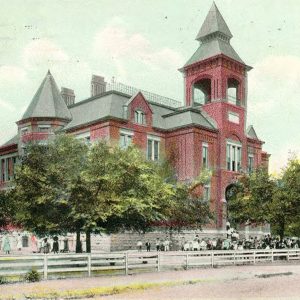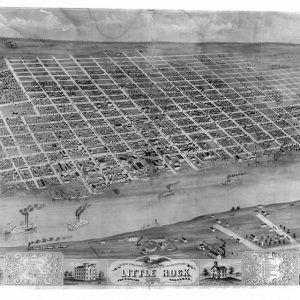calsfoundation@cals.org
Fort Steele
Fort Steele was the principal Union fortification guarding the southern approaches to Little Rock (Pulaski County) after Federal forces took possession of the state capital in 1863.
After the Little Rock Campaign culminated in the capture of the capital city on September 10, 1863, Federal officials assessed the fortifications the Confederates had erected to defend the city and began plans for improving the defenses with an emphasis on the approaches from the south. On November 9, Union commander Major General Frederick Steele wrote that his chief engineer, Captain Junius B. Wheeler, had “laid out and commenced a square redoubt, which will command the city and the principal approaches.”
The fortification was located in an area roughly bounded by modern Fifteenth, Sixteenth, Gaines, and Arch streets but was then on undeveloped land owned by the estate of Roswell Beebe on high ground south of the city. The large, square fortification commanded the road to Benton and was surrounded by a trench six feet deep and eight feet wide. While Confederate lieutenant general Edmund Kirby Smith held that the Union works were built by “1,000 negroes,” a Wisconsin private wrote, “Other soldiers had to build a fort. About 200 men were at work daily, all through the winter, building.” The bastion was essentially finished by mid-December.
The first reference in the official records to the fortification as Fort Steele was in late March 1864, but it apparently bore that appellation before Steele left Little Rock on March 23 for the failed Camden Expedition into southwestern Arkansas. A weary Iowa soldier returning to Little Rock from the campaign on May 3 wrote that “at 10:30 Fort Steele was in sight; and not even the memory of the dreary days of fatigue-duty on its walls could make it seem unwelcome.”
The Federals kept fortifying Little Rock and clearing fields of fire in front of Fort Steele and the other major ramparts, while continuing improvements on Fort Steele itself. On July 19, 1864, Brigadier General Eugene Carr noted that “they are throwing up the glacis at Fort Steele on the east side, the side nearest town. I…recommend that the engineers be directed to make the glacis first on the side most exposed to attack, which is the west.” The final reference to improvements on Fort Steele in the official records was on September 1, 1864, when Union officials anticipated an attack by the enemy and ordered that “the fort will be provided with a drawbridge to prevent a surprise.”
Fort Steele would never be tested by Confederate assault, though, and survived for many years after the war until Little Rock’s continued growth to the south led to development of new neighborhoods in the area. The fort is shown in an 1871 bird’s-eye-view map of Little Rock, surrounded by an encroaching street grid.
Residential development near Fort Steele began in the late 1860s, and a school named for the fort was built in 1885. It stood on 13th Street between State and Izard streets until burning to the ground on April 3, 1915.
The Arkansas Civil War Sesquicentennial Commission approved a historical marker recognizing Fort Steele to be placed near the fort site in 2013.
For additional information:
Allen, A. Hall. “Fort Steele School Meets Fiery End.” Arkansas Democrat Magazine, July 3, 1966, pp. 5–6.
———. “Little Rock Was Ringed by Fortifications.” Arkansas Democrat Magazine, June 20, 1965, pp. 8, 10.
Christ, Mark K. “’Well-built and formidable’: Fortifying Little Rock, 1863–1865.” Pulaski County Historical Review 62 (Spring 2014): 16–21.
Christ, Mark K., ed. “This Day We Marched Again”: A Union Soldier’s Account of War in Arkansas and the Trans-Mississippi. Little Rock: Butler Center Books, 2014.
“The Fort Steele School.” Arkansas Gazette, September 20, 1885, p. 5.
Ruger, A. “Bird’s Eye View of the City of Little Rock, The Capitol of Arkansas.” Butler Center Map Collection, Butler Center for Arkansas Studies, Central Arkansas Library System, Little Rock, Arkansas.
Sherwood, Dina, “Forts of the Civil War.” Arkansas Gazette Magazine Section, December 11, 1938, pp. 1, 2.
Urwin, Gregory G. W., and Kathy Kunziger Urwin, eds. History of the 33d Iowa Infantry Volunteer Regiment, 1863–6. Fayetteville: University of Arkansas Press, 1999.
The War of the Rebellion: A Compilation of the Official Records of the Union and Confederate Armies, Series I, Vol. 22, part 2, pp. 701, 742, 1110. Washington DC: Government Printing Office, 1888.
The War of the Rebellion: A Compilation of the Official Records of the Union and Confederate Armies, Series I, Vol. 34, part 2, p. 773; part 3, p. 618. Washington DC: Government Printing Office, 1891.
The War of the Rebellion: A Compilation of the Official Records of the Union and Confederate Armies, Series I, Vol. 41, part 2, pp. 262, 487; part 3, p. 5. Washington DC: Government Printing Office, 1893.
Mark K. Christ
Central Arkansas Library System
 Civil War through Reconstruction, 1861 through 1874
Civil War through Reconstruction, 1861 through 1874 Military
Military Fort Steele School
Fort Steele School  Little Rock and Fort Steele
Little Rock and Fort Steele 



Comments
No comments on this entry yet.